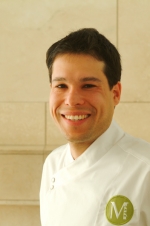Interview with Chef Lee Gross of M Café de Chaya - Los Angeles, CA
Antoinette Bruno: Why did you start cooking? What or who inspired you to become a chef?
Lee Gross: My mother couldn’t cook. I was an artist and hungry, so I taught myself how to cook to feed myself.
AB: Did you attend culinary school? Would you recommend culinary school to aspiring chefs today? Do you only hire chefs with culinary school backgrounds?
LG: I have a 4-year degree from Johnson and Wales. I also studied macrobiotics at the Kushi Institute in Becket, MA. Yes, I would recommend culinary school. Most people who work for me have been trained within the Chaya family restaurants.
AB: Who are your mentors? What are some of the most important things you’ve learned from them?
LG: Julie Jordan, a chef in Ithaca, NY, turned me on to macrobiotic cooking. Phillipe Jeanty at Domaine Chandon – he taught me to employ the French technique that I learned in school and actually use it! He also taught me love. George and Johanne from Al Forno in Providence, RI, taught me passion, as opposed to love, and how to run a restaurant.
AB: What is your philosophy on food and dining?
LG: There is a lot of baggage surrounding the macrobiotics practice and its food – I don’t think too hard about it. I live and eat in the moment while listening to my body.
AB: Are there any secret ingredients that you especially like? Why?
LG: Miso – fermented food that has a depth of flavor. Umeboshi extract and paste from the pickled plums. It’s magic, a tonic for the body, and its flavor is off the charts. Shiso – its aroma and flavor is a cross between basil and mint. Agar – this sea vegetable is very healthy and can be used everywhere that regular gelatin can be used. Kudzu root – for its thickening power and positive effect in the small intestine.
AB: What is your most indispensable kitchen tool?
LG: The Suribachi-surikogi, a Japanese mortar and pestle that brings me back to primal cooking. It fills you with the aroma of what you are grinding. The act of using it is balancing.
AB: Is there a culinary technique that you have either created or use in an unusual way?
LG: I make cheese from tofu. I culture tofu with miso, pickling it to make a parmesan-like cheese. I also make chevre.
AB: What is your favorite question to ask during an interview for a potential new line cook?
LG: I ask them if they like to eat. Indifference makes me skeptical.
AB: What tips would you offer young chefs just getting started?
LG: Go to school if you can afford it. Study culture – that is the best way to study cuisine. Watch cooking shows but not on The Food Network. Read everything.
AB: What are your favorite cookbooks?
LG: The Book of Tempeh – it is an encyclopedia detailing its traditional use and how it is used culturally. Bill Shrutleff – his whole series and The Cabbage Town Café Cookbook.
AB: What cities do you like for culinary travel?
LG: Northern California – everything I ate tasted like manna. New York – there’s nothing like it for taste and flavors.
AB: What are your favorite restaurants – off the beaten path – in Los Angeles?
LG: Hungry Cat and Inaka, which is straight-up macrobiotic in the Japanese style.
AB: What trends do you see emerging in the restaurant industry now?
LG: Much more use of whole food and whole grains. Sustainability is growing. Plant-based food interest is growing and traditional food is coming back.
AB: Where do you see yourself in 5 to 10 years?
LG: Teaching on some level. I want to be at the forefront of this movement. I want to help change the industry for the better.






